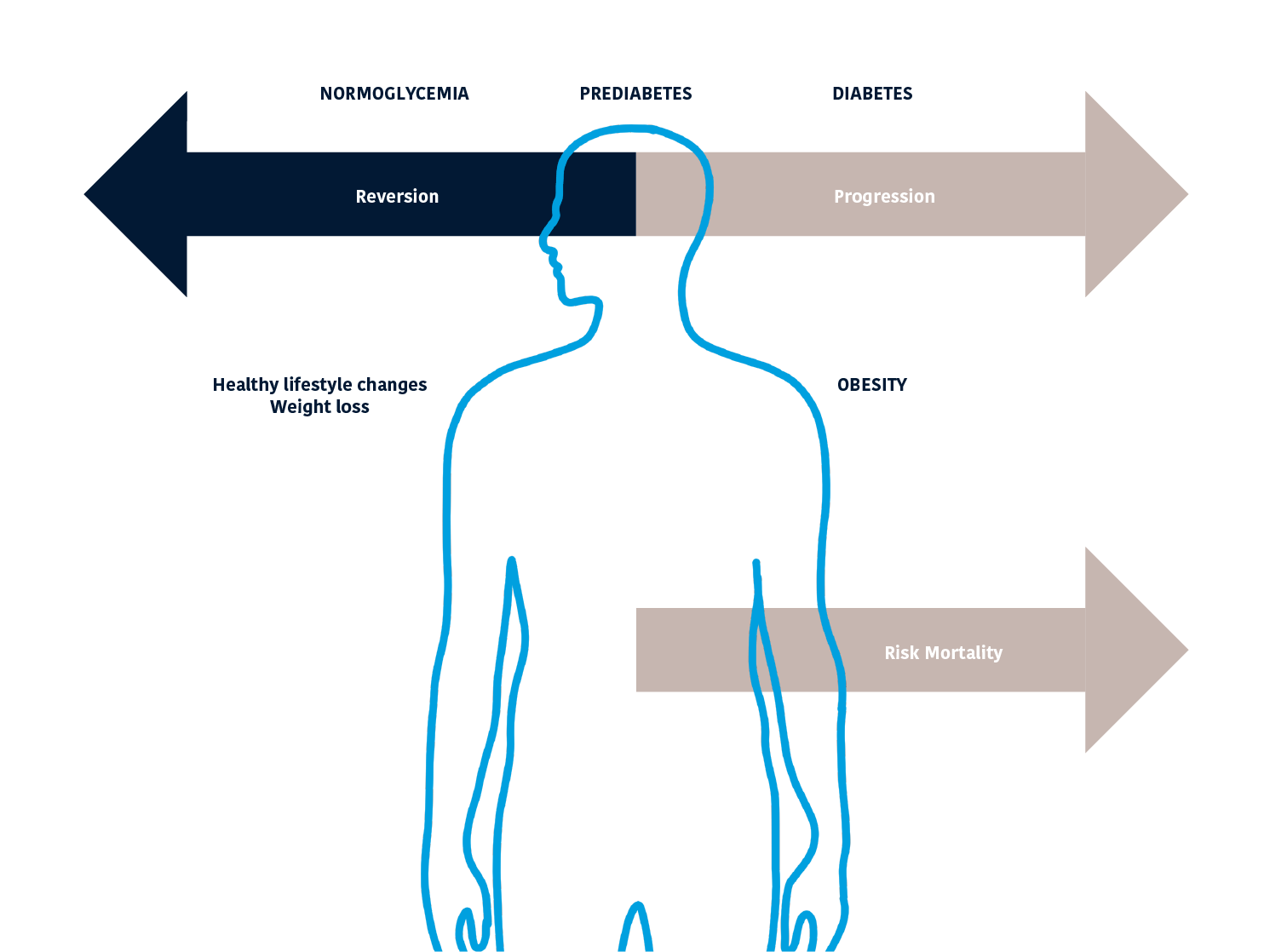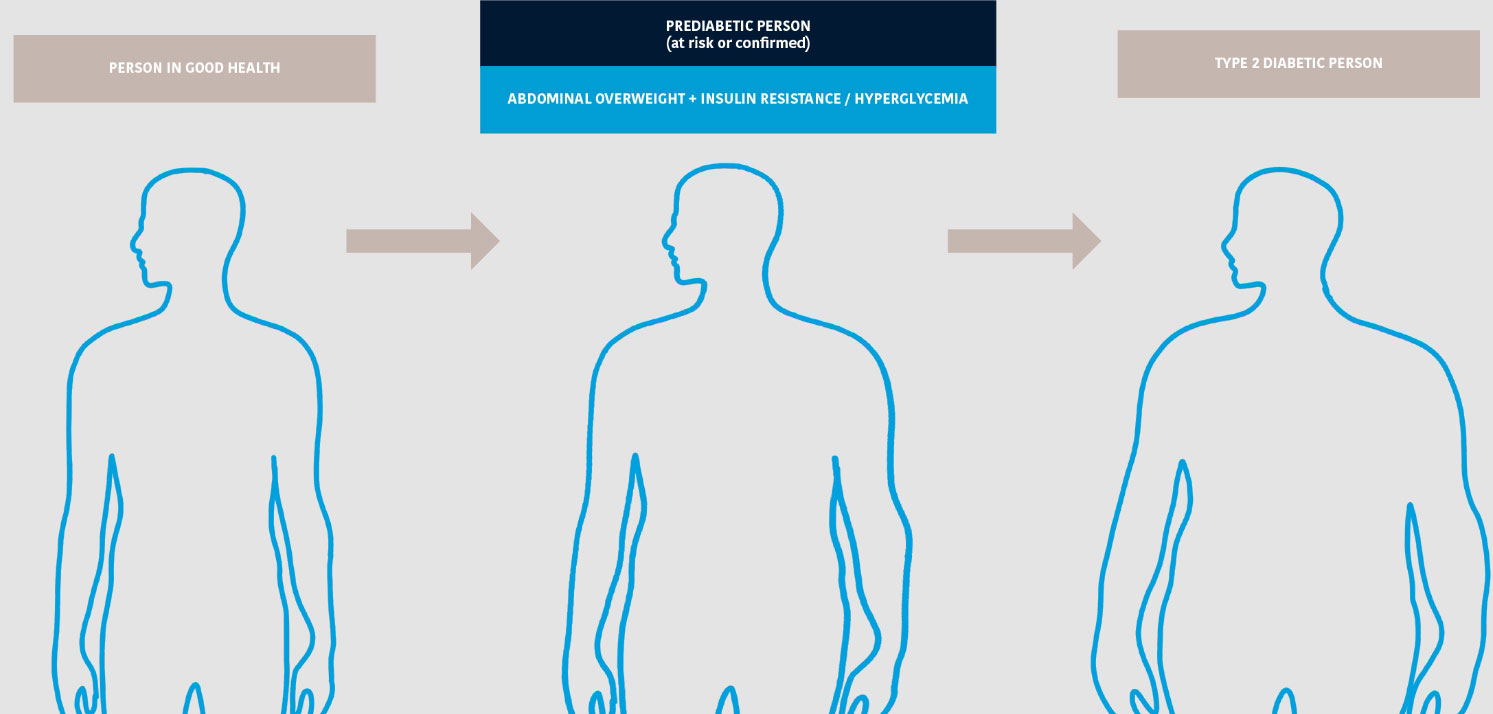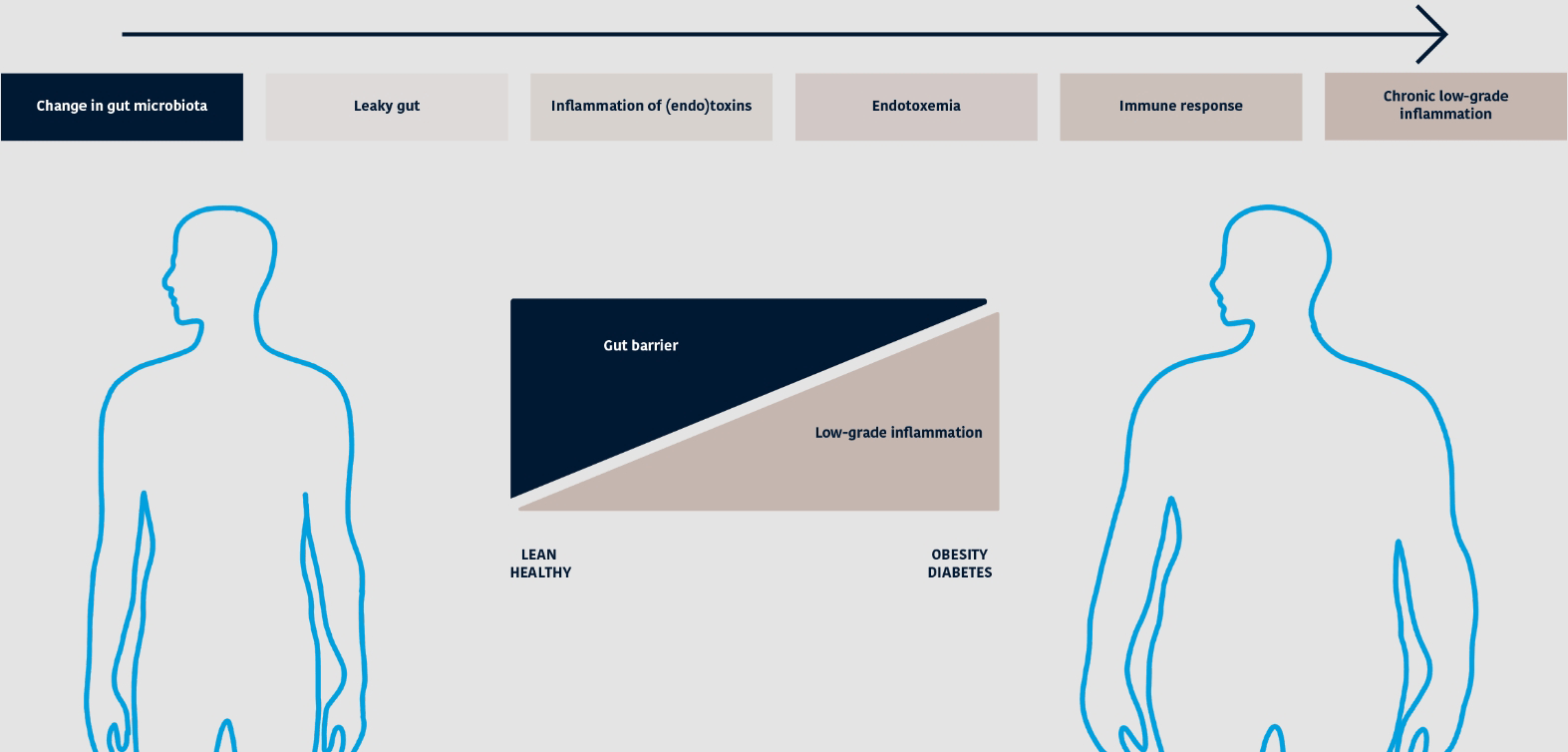Diabesity: obesity and diabetes
The number of overweight individuals is fast increasing worldwide, which in turn has resulted in a rise in the prevalence of type 2 diabetes.
The International Diabetes Federation (IDF) has predicted that the number of individuals with diabetes is expected to rise to 552 million by 2030 1, and the World Health Organization (WHO) has called obesity and diabetes the “21st-century epidemic”.
The Akkermansia CompanyTM is committed to using Akkermansia muciniphila in the creation of innovative health solutions that target the common threat of ‘leaky gut’.
In so doing, we aim to help prevent the cycle of chronic low-grade inflammation; a root cause of excess weight gain and increased blood sugar that can, in turn, lead to obesity and diabetes.
Regardless of the precise cause-and-effect relationship, the term “diabesity” was coined by Francine Kaufman in 2005 to emphasise the close relationship between diabetes and obesity; obesity and type 2 diabetes frequently occur together, and the vast majority of type 2 diabetic individuals are or have been overweight.
Along with genetic susceptibility, being overweight is the most important risk factor for type 2 diabetes. The term “diabesity” singles out excess body weight as the major cause of type 2 diabetes. 2 & 3

Obesity: a worldwide epidemic
The terms ‘overweight’ and ‘obese’ are both defined as abnormal or excessive fat accumulation that may impair health. A common indicator used to estimate them is the Body Mass Index (BMI). It is based on the weight and the height of an individual: BMI = mass (kg) / height (m²).
In short, a person with a BMI greater than or equal to 25 is considered overweight and above or equal to 30 is considered obese. The worldwide prevalence of obesity has nearly tripled between 1975 and 2016. 4
In other words, more than 1.9 billion adults (39% of the adult global population) were overweight by 2016, of which over 650 million were obese (33% of the overweight adult population). 5 In Europe, more than half the population was overweight in 2019, and up to 30% was obese. 6
But as the world deepens its understanding of the disease, there is still a stigma and weight bias associated with obesity, which contributes independently to increased morbidity and mortality 7. Misconceptions about obesity being a result of personal choice and lack of self-control unfairly blames and shames those who are living with the disease8.
The reality is much more complicated. Obesity is a heterogeneous disease that presents in different ways in different patients. As with any chronic disease, assessment, treatment and long-term support must be tailored to the patient’s individual needs.
Obesity can have a variety of root causes including side effects of certain medications, biological factors, other chronic diseases, sociocultural practices and beliefs, social determinants of health, built environment and psychological factors such as mood, anxiety, binge-eating disorder, attention-deficit/hyperactivity disorder, and personal self-worth and identity 9.
The stigma around obesity has a negative impact on the quality of healthcare provided to people living with the condition. 10 and 11. Management of obesity has historically not been effective within healthcare 12, 13, 14, and a significant number of HCPs feel under-resourced to deliver obesity care 8, 15, 16.
Obesity in numbers
According to the World Health Organization 17 :
WORLDWIDE OBESITY HAS
NEARLY TRIPLED
NEARLY TRIPLED FROM THE PERIOD OF 1975
UNTIL 2021.
IN 2016,
MORE THAN 1.9 BILLION
ADULTS, 18 YEARS AND OLDER, WERE OVERWEIGHT. OF THESE OVER 650 MILLION WERE OBESE.
39%
OF ADULTS AGED 18 YEARS AND OVER WERE OVERWEIGHT IN 2016, AND
13% WERE OBESE.
MOST OF THE WORLD'S POPULATION
LIVE IN COUNTRIES WHERE OVERWEIGHT AND OBESITY KILLS MORE PEOPLE THAN UNDERWEIGHT.
39 MILLION CHILDREN
UNDER THE AGE OF 5 WERE OVERWEIGHT OR OBESE IN 2020.
OVER 340 MILLION
CHILDREN AND ADOLESCENTS AGED 5-19 WERE OVERWEIGHT OR OBESE IN 2016.
For adults, WHO defines overweight and obesity as follows; overweight is a BMI greater than or equal to 25; and obesity is a BMI greater than or equal to 30.
Obesity is preventable.
Prediabetes and diabetes
The prevalence of prediabetes is also increasing and becoming a major public health issue. 18 Prediabetes is defined as an intermediate state of hyperglycaemia in which glucose levels rise above the normal level, but are below the diagnostic levels of diabetes. 19
There are no symptoms clearly associated with prediabetes. It is a condition that can remain silent and unidentified for many years, laying the basis for severe complications – but a simple blood sample analysis can easily identify people at risk. 20

The gut microbiota manages host metabolism, Patrice D. Cani, Nature Review, 2013

IMPLEMENT KEY INTERVENTIONS TO GET BACK TO NORMAL GLYCAEMIA

PREVENT THE RISK OF DEVELOPING TYPE-2 DIABETES.
Diabetes in numbers
1 IN 10 ADULTS (20-79 YEARS)
HAS DIABETES - 537 MILLION PEOPLE. BY 2045, THIS NUMBER WILL INCREASE TO 783 MILLION. 24
1 IN 2 ADULTS IS
UNDIAGNOSED
- 240 MILLION PEOPLE
9%
OF GLOBAL HEALTH EXPENDITURE WAS SPENT ON DIABETES -
USD 966 BILLION
6.7 MILLION DEATHS
ATTRIBUTED TO DIABETES
541 MILLION ADULTS
ARE AT INCREASED RISK OF DEVELOPING TYPE 2 DIABETES
MORE THAN 1.2 MILLION
CHILDREN AND ADOLESCENTS (0-19 YEARS) ARE LIVING WITH TYPE 1 DIABETES
The role of imbalanced gut microbiota in obesity and prediabetes

How to tackle diabesity?
Clinical trials have proven Akkermansia reduces low grade inflammation, which is a root cause of excess weight gain and increased blood sugar that can, in turn, lead to obesity and diabetes.
The Akkermansia Company™ is committed to using Akkermansia muciniphila in the creation of food supplements which will increase your Akkermansia levels.
REFERENCES
1 Whiting, D.R., Guariguata, L., Weil, C. & Shaw, J. IDF diabetes atlas: global estimates of the prevalence of diabetes for 2011 and 2030. Diabetes Res Clin Pract 94, 311-321 (2011).
2 Shafrir, E. Development and consequences of insulin resistance: lessons from animals with hyperinsulinaemia. Diabetes Metab22, 122-131 (1996).
3 Astrup, A. & Finer, N. Redefining type 2 diabetes: ‘diabesity’ or ‘obesity dependent diabetes mellitus’? Obes Rev 1, 57-59 (2000).
4 Weir, C. B. and A. Jan (2023). BMI Classification Percentile And Cut Off Points. StatPearls. Treasure Island (FL), StatPearls Publishing. Copyright © 2023, StatPearls Publishing LLC.
5 https://www.who.int/news-room/fact-sheets/detail/obesity-and-overweight
6 Eurostat, Overweight and obesity – BMI statistics – https://ec.europa.eu/eurostat/statistics-explained/index.php?title=Overweight_and_obesity_-_BMI_statistics
7 Sutin AR, Stephan Y, Terracciano A. Weight discrimination and risk of mortality. Psychol Sci. 2015 Nov;26(11):1803–11.
8 Kirk SFL, Price SL, Penney TL, Rehman L, Lyons RF, Piccinini-Vallis H, et al. Blame, shame, and lack of support: a multilevel study on obesity management. Qual Health Res. 2014 Jun;24(6):790–800.
9 Luig T, Anderson R, Sharma AM, Campbell-Scherer DL. Personalizing obesity assessment and care planning in primary care: patient experience and outcomes in everyday life and health. Clin Obes. 2018 Dec;8(6):411–23.
10 Alberga AS, Edache IY, Forhan M, Russell-Mayhew S. Weight bias and health care utilization: a scoping review. Prim Health Care Res Dev. 2019 Jul 22;20:e116.
11 O’Donoghue G, Cunningham C, King M, O’Keefe C, Rofaeil A, McMahon S. A qualitative exploration of obesity bias and stigma in Irish healthcare; the patients’ voice. PLoS One. 2021;16(11):e0260075.
12 Obesity Canada. Report card on access to obesity treatment for adults in Canada 2017. Edmonton: Obesity Canada; 2017.
13 World Obesity. World Obesity Report Card for Ireland. 2020.
14 Health Service Executive (HSE). Model of Care for the Management of Overweight and Obesity. Dublin: Royal College of Physicians in Ireland; 2021.
15 Greener J, Douglas F, van Teijlingen E. More of the same? Conflicting perspectives of obesity causation and intervention amongst overweight people, health professionals and policy makers. Soc Sci Med. 2010 Apr;70(7):1042–9.
16 Janke EA, Ramirez ML, Haltzman B, Fritz M, Kozak AT. Patient’s experience with comorbidity management in primary care: a qualitative study of comorbid pain and obesity. Prim Health Care Res Dev. 2016 Jan;17(1):33–41.
17 World Health Organization, Obesity and overweight, July 2021
18 Echouffo-Tcheugui JB, Selvin E. Prediabetes and What It Means: The Epidemiological Evidence. Annu Rev Public Health. 2021 Apr 1;42:59-77. doi: 10.1146/annurev-publhealth-090419-102644. Epub 2021 Dec 23. PMID: 33355476; PMCID: PMC8026645.
19 https://diabetes.org/diabetes/prediabetes
21 Tabák AG, Herder C, Rathmann W, Brunner EJ, Kivimäki M. Prediabetes: a high-risk state for diabetes development. Lancet. 2012 Jun 16;379(9833):2279-90. doi: 10.1016/S0140-6736(12)60283-9. Epub 2012 Jun 9. PMID: 22683128; PMCID: PMC3891203.
22 Galaviz KI, Narayan KMV, Lobelo F, Weber MB. Lifestyle and the Prevention of Type 2 Diabetes: A Status Report. Am J Lifestyle Med. 2015 Nov 24;12(1):4-20. doi: 10.1177/1559827615619159. PMID: 30202378; PMCID: PMC6125024.
23 IDF Diabetes Atlas 10th Edition 2021
25 Martel, J., et al. (2022). “Gut barrier disruption and chronic disease.” Trends in Endocrinology & Metabolism 33(4): 247-265
26 Valdes A M, Walter J, Segal E, Spector T D. Role of the gut microbiota in nutrition and health BMJ 2018; 361 :k2179 doi:10.1136/bmj.k2179
27 Cani, P. D., et al. (2007). “Metabolic endotoxemia initiates obesity and insulin resistance.” Diabetes 56(7): 1761-1772.
